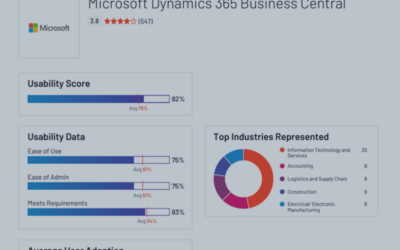Firmly planted in the realm of MVPs, Dynamics 365 boasts of prowess. But is it the ideal fit for you?
Amidst the sea of ERP solutions, Dynamics 365 enjoys a big headline. Yet, the business world brims with alternatives waiting to show their teeth. Venturing past the usual Dynamics 365 trail, we plunge into an exploration of top-rated alternatives.
These are solutions that aren’t confining themselves to just keeping up with Dynamics 365, but are setting new standards of ERP excellence.
Your search for the perfect ERP solution doesn’t have to end at Dynamics 365. In this labyrinth of choices, perhaps your perfect match lies hidden, awaiting discovery.
Words like “versatility”, “user-friendly”, and “cost-effective” don’t just belong to Dynamics 365. Open your horizon to the untapped potential of Dynamics 365 alternatives today.
Unveiling the Top Dynamics 365 Alternatives
- Explore 3 popular Dynamics 365 alternatives.
- Discover properties across different parameters, such as features, deployment options, etc.
- Cultivate a clear picture to aid in the decision-making process while choosing the best ERP system.
Turning our attention from Dynamics 365, let’s steer the discussion towards its top-tier contenders. These alternatives come packed with diverse features, deployment options, and more. This will empower anyone seeking a comparison or contemplating options beyond Dynamics 365.
Top 3 Alternatives to Dynamics 365
ERP systems integrate and manage key business processes. Every alternative to Dynamics 365 has a unique spin on leveraging technology, data, workflows, and communication across organizations.
Acumatica Cloud ERP
Acumatica is currently the fastest growing cloud ERP. If flexibility is your top concern, then Acumatica should make it to your list. Its modular structure and licensing model based on transaction volume, and not the number of users, make it highly adaptable for businesses of any size.
NetSuite ERP
NetSuite ERP is a scalable, cloud-based ERP solution designed for fast-growing businesses. With NetSuite, businesses can streamline their operations and speed up growth. Offering full visibility into financials, customers, inventory, and more, NetSuite provides the tools needed to make informed decisions.
SAP Business One ERP
SAP Business One, also known as SAP B1, is an enterprise resource planning (ERP) application designed specifically for small and medium-sized businesses (SMBs). Developed by the German company SAP SE, its primary goal is to automate key business functions across various areas, including finance, operations, and human resources.
Comparing Dynamics 365 with Competitors
In this impactful analysis, we’ll explore:
- Spot-on feature comparison of Dynamics 365 with its rivals.
- Distinct pricing model analysis to make informed decisions.
Feature Comparison
There are key ERP features that matter most to businesses – process integration, reporting capabilities, customization, and scalability. Dynamics 365 comes loaded with many of these. But how does it stand against its competitors?
Process Integration
Dynamics 365 is a big wig when it comes to process integration – combining finance and operations, sales, and customer service. But how does this measure up against competitors like Acumatica, NetSuite or SAP, known for their all-in-one suites? Let’s dissect this.
Reporting Capabilities
The ability to derive actionable insights is a game-changer. Let’s delve into the specific reporting strengths of these competitors.
| System | Reporting Capabilities |
| Acumatica |
|
| NetSuite |
|
| SAP Business One |
|
| Microsoft Dynamics 365 |
|
Customization and Scalability
One size doesn’t fit all. Companies, from start-ups to conglomerates, require solutions that are customizable and scalable. While Dynamics 365 offers an excellent degree of customization, its rivals may offer more or less. Let’s see how this landscape shapes up.
| System | Customization | Scalability |
| Microsoft Dynamics 365 |
|
|
| NetSuite |
|
|
| Acumatica |
|
|
| SAP Business One |
|
|
Pricing Comparison
A pricing breakdown, often a deciding factor, needs scrutiny. Here, we compare the pricing models of Dynamics 365 and its major competitors.
Dynamics 365 Pricing
Choosing the right Enterprise Resource Planning (ERP) system involves understanding not just its features and capabilities, but also its pricing and licensing structures. In this section, we’ll delve into the pricing and licensing details for four prominent ERP solutions: Microsoft Dynamics 365, NetSuite, Acumatica, and SAP Business One.
Microsoft Dynamics 365:
- Licensing Model: Microsoft Dynamics 365 operates on a named user subscription model, offering various user types tailored to different business needs.
- User Types: Full User and Light User.
- Pricing: Varied based on user type and specific applications, starting at $50 per user/month for Customer Service Professional and $70 per user/month for Business Central Essentials.
- Modules and Features: Comprehensive suite covering Sales, Finance, Marketing, Supply Chain, and more.
- Customization and Scalability: Highly customizable with integration capabilities, suitable for businesses of all sizes.
Competitors’ Pricing
Competitors like SAP, Oracle NetSuite, and others also have different pricing tiers. See below for an head to head comparison of key pricing information. Use the information as a starting point to determine which solution might give you the biggest bang for your budget.
| Feature | NetSuite | Acumatica | SAP Business One |
| Licensing Model | Subscription-based with additional user access fees | Subscription-based with annual licensing and implementation costs | Designed for small and medium-sized businesses (SMBs) with flexible pricing |
| User Licenses |
|
|
Cost varies based on the number of users and modules chosen |
| Modules and Features | Financials, Inventory Management, Sales and CRM, E-commerce, Manufacturing | Small Business, Advanced, and Enterprise editions catering to different organizational sizes and complexities | Finance, CRM, E-commerce, Industry-specific editions |
| Customization and Scalability | Customizable through value-added resellers, scalable for startups to enterprises | Highly customizable with flexible modules, scalable to evolving business needs | On-premises and cloud-based options are available for flexibility |
While these overviews provide a glimpse into the pricing and licensing structures of these ERP solutions, it’s crucial to engage directly with vendors or partners to get accurate quotes tailored to your specific business needs and requirements.
License Flexibility
When buying ERP software, the initial cost is only half the story. You also need to consider how well the licensing costs adapt to your business and how it will change as it grows.
Microsoft Dynamics 365:
- Named User Subscription Model: Offers flexibility by allowing you to choose user types (full user or light user).
- Customizable Licensing: You can select specific apps/modules based on your needs.
- Scalability: Scales from small businesses to large enterprises.
NetSuite:
- Subscription-Based Pricing: Provides flexibility with a base license and additional user access.
- Customizable Modules: Allows you to tailor the system to your business processes.
- Commerce-Ready ERP: Allows customization for customer-facing e-commerce.
Acumatica:
- Subscription Model: Offers annual licensing with customization options.
- Editions: Choose from Small Business, Advanced, or Enterprise based on your requirements.
- User-Friendly Customization: Intuitive interface for easy adaptation.
SAP Business One:
- Annual License: Provides flexibility with a fixed annual licensing cost.
- Industry-Specific Editions: Customizable for various industries.
- Deployment Options: Choose between on-premises and cloud-based.
Fees for Additional Modules or Users
Microsoft Dynamics 365:
User Licenses:
- Full User: Access to all functionalities within a specific app (e.g., Sales, Finance, Customer Service).
- Light User: Limited access for specific tasks (e.g., read-only access, approvals).
Additional Modules:
- You can expand functionality by adding specific modules (e.g., Marketing, Supply Chain, Human Resources).
- Pricing varies based on the chosen modules.
NetSuite:
User Licenses:
- Full License: Ranges from $100 to $200 per person per month.
- Limited License: Costs between $50 to $100 per person per month.
- Determines the level of access to the system.
Additional Modules:
- You can enhance NetSuite by adding modules for specific tasks (e.g., Inventory Management, E-commerce).
- The calculation of costs is based on the number of modules being accessed.
Acumatica:
User Licenses:
- For all editions except small business, Acumatica is the only ERP in the industry to not charge per user license fees. Instead, businesses can have an unlimited number of users and they pay based on the amount of computing resources they consume.
Additional Modules:
- Tailor Acumatica by adding flexible modules (e.g., Financials, Project Management).
- Costs depend on the specific modules chosen.
SAP Business One:
User Licenses:
- SAP B1 targets small and medium-sized businesses (SMBs).
- Licensing costs are typically based on the number of users.
Additional Modules:
- SAP Business One provides industry-specific editions and additional features.
- Costs vary based on the modules required.
A Note about Implementation Cost
Because implementation cost varies so widely from project to project based on the size and complexity of a client’s business, it is nearly impossible to compare this cost to one system versus another. Once you have created a short list of ERP systems, you feel fit your business requirements; we recommend you find an implementation consultant who specializes in each one and can give you a customized quote. That way, you can compare your own predicted implementation costs across all the systems you are considering and make the choice that makes the most sense for your budget.
Take Your Time Comparing ERP Systems on Price
Buckle up. Take a moment to assess the information. There is no rush here. The key is to consider each factor to determine which solution might best meet your needs.
Deep Dive into Features of Dynamics 365 Alternatives
There’s a vast field of Enterprise Resource Planning (ERP) solutions other than Dynamics 365, each with its own set of unique features and offerings. Let’s inspect some of the top alternatives and the ace up in their sleeves.
Acumatica
Acumatica, as a cloud ERP solution, stands out from the competition because of several unique features and strengths. Specifically, Acumatica’s commitment to user-centric design, continuous innovation, and integrated features like Acumatica Payments make it a leader in the ERP space, addressing real-world needs for businesses of all sizes. See below for more detail.
User-Centric Design and Accessibility:
- Acumatica emphasizes an accessible and intuitive interface.
- Supports mobile and remote work capabilities, allowing users to be productive from any location.
- User-friendly design encourages adoption and efficiency.
Continuous Innovation Based on Real-World Needs:
- Acumatica releases two major updates every year, driven by real-user feedback and requests.
- Ongoing innovation ensures that the solution addresses current challenges and predicts changes in the business landscape.
- Collaborative efforts with partners, customers, and creators lead to novel solutions.
Acumatica Payments:
Integrated credit card and ACH collections within Acumatica.
Unique features include:
- Gift Cards: Improve loyalty programs and gain repeat customers.
- Click to Pay Portal: Enable customer self-service.
- Mobile App: Easily collect payments using the Acumatica app on mobile phones.
SAP Business One
SAP Business One is known for its comprehensive business management tools. It delivers tools for controlling finances, sales, customer relationships, and inventory.
Sales and Customer Management:
- Oversee the entire sales process and customer lifecycle efficiently.
- From initial contact to final sale, after-sales service, and support, SAP Business One covers it all.
- Enhanced customer relationship management ensures better customer satisfaction.
Purchasing and Inventory Control:
- Optimize purchasing practices and control costs.
- Manage the complete order-to-pay cycle, including receipts, invoices, returns, and payments.
- Efficient inventory management ensures smooth operations.
Business Intelligence and Analytics:
- Create timely and accurate reports based on company-wide data.
- Analytics and reporting tools empower employees to make smart, confident decisions faster.
- Capturing critical information and making it instantly available company-wide drives efficiency.
In-Memory Platform:
- SAP Business One leverages an in-memory platform for faster data processing.
- Real-time insights and analytics enhance decision-making capabilities.
- Efficient data handling contributes to overall system performance.
NetSuite
NetSuite’s industry-specific capabilities, user-friendly design, and powerful features make it an interesting choice for organizations seeking an all-in-one cloud ERP solution.
CRM and Accounting/ERP Integration:
- NetSuite combines customer relationship management (CRM) and accounting/ERP functionalities seamlessly.
- This integration ensures a holistic view of customer interactions, financial transactions, and order processing.
- Streamlined processes lead to improved customer service and operational efficiency.
SuiteAnalytics Business Intelligence:
- NetSuite’s SuiteAnalytics provides robust data analysis tools.
- Users can convert raw data into useful insights, which can help them identify potential business opportunities, areas to save costs, and detect fraud.
- Enhanced reporting and analytics empower decision-makers across the organization.
SuiteFlex Customization and Extension:
- NetSuite’s SuiteFlex allows extensive customization and extension of the platform.
- Developers can create custom scripts, workflows, and applications to tailor NetSuite to specific business needs.
- Flexibility ensures that NetSuite adapts to growing requirements without compromising performance.
As you can see, it’s clear that there’s no one-size-fits-all solution. Each software has unique features tailored to cater to different business needs. The task is to align those with your specific business requirements. That true understanding acts as a compass in the vast sea of ERP solutions, guiding you towards the one that’s just right for your business.
Evaluating User Experience of Dynamics 365 Alternatives
Deciding on an Enterprise Resource Planning (ERP) system for a business does not merely rest on cost-effectiveness. While it’s crucial, myriads of other features can drastically shape an ERP system’s suitability for your business. User experience is one such indispensable feature.
Importance of User Reviews
User reviews offer indispensable insights into real-life experiences with the software. They highlight the software’s strengths and weaknesses from the perspective of those who use the software daily.
By paying close attention to reviews, businesses can identify common issues that users often face with specific ERP software. A high incidence of similar complaints could show problematic areas and potential pitfalls with the software, which could be costly and time-consuming to overcome.
Understanding Feedback
Feedback comes not only from customer reviews, it also includes professional critiques, vendor evaluations, and expert assessments. Comparing user-based feedback with expert reviews allows businesses to capture a holistic picture of an ERP’s user experience.
That comprehensive outlook enables businesses to evaluate if a solution’s design and functionality align with the company’s operational needs, objectives, and resources. Through feedback assessment, businesses can uncover substantial factors such as the software’s user-friendliness and its adaptability to the existing workflow.
Where to Look for Reputable User Feedback Information
There are many places you can find information on ERP software solutions. However, like most things in life, they are not all created equal. Some sources we recommend are potential clients look when they’re evaluating ERP software are.
- Software Advice
- G2
- ERP focus
- Analyst websites like Gartner and Nucleus Research
Making the Right Choice: Dynamics 365 or an Alternative?
Microsoft’s Dynamics 365 has gained fame for its seamless integration with other Microsoft products, comprehensive features, and overall scalability, which can be a game-changer for some companies. However, no platform is perfect. Dynamics 365 too has its deficiencies. Some users find the interface not so user-friendly, while others gripe about its high licensing costs.
Factors to Consider
Remember, the ideal ERP solution hinges on your individual business needs. Key determinants include the industry you operate in, your company size, the specific operational needs, and cost-effectiveness. Tailoring these factors helps you make an informed decision and choose an ERP that best fits your business.
Navigating Dynamics 365 Alternatives: A Quick Recap
Dynamics 365 has notable strengths, but alternatives like Acumatica, Oracle NetSuite, and SAP also bring strong offerings. Your specific needs dictate which platform reigns supreme.
You’re armed with the details to make an informed decision. Remember that this information serves as your compass to navigate the vast landscape of ERP solutions.
Now, you’re ready to put this knowledge into action by carefully evaluating your business requirements against these platform strengths. Don’t be afraid of diving deeper into each option. Each additional exploration only brings you closer to finding the perfect fit. As you do, note your findings in our ERP evaluation checklist. Once you’ve filled it out, you will see immediately which solution is the best fit for your needs.



